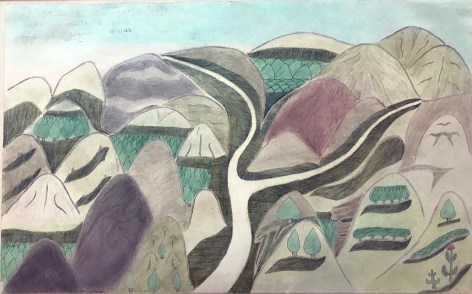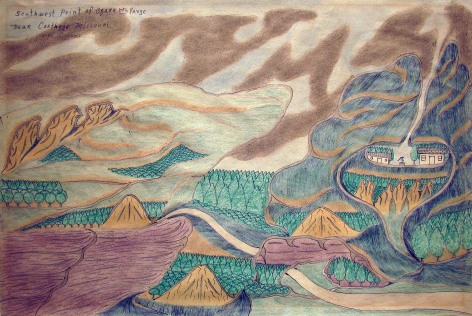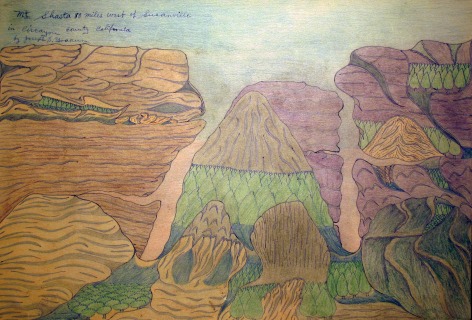
Joseph Yoakum
Weeping Pebble on Lake Shasta Nevada
Signed by Joseph Yoakum
12 x 18 inches
Colored pencil and ink on paper
JY 184
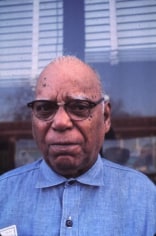
Portrait of Joseph Yoakum
1890-1972
Photo Courtesy Prints and Drawings Dept.
Art Institute of Chicago
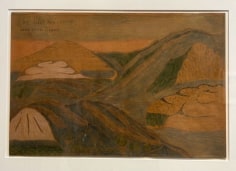
Joseph Yoakum
Mt. Jebel Ram 5.397 Pt
Near Aquba Jordan
12 x 17 ¾ inches, unframed
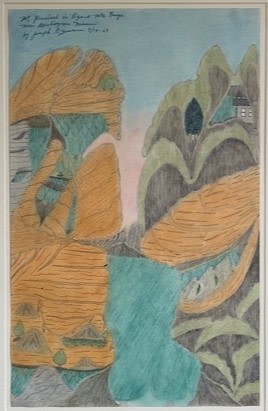
Joseph E. Yoakum
Mt. Pinnacle in Ozark Mtn Range, near Bowlingreen Missouri
By Joseph E. Yoakum
7/14-69
19 x 12 inches
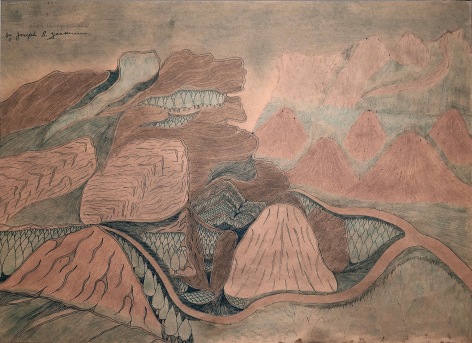
Joseph Yoakum
Signed: by Joseph E. Yoakum
18 x 24 inches
Ballpoint pen, colored pencil on paper
JY 181
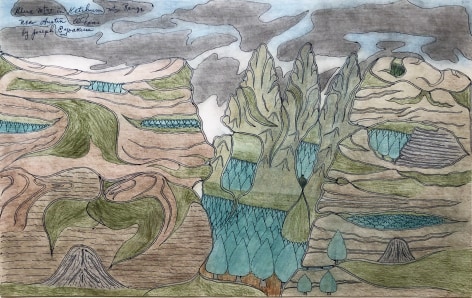
Joseph E Yoakum
Blue Mtns in Ketchum Mtn Range
Near Austin Texas
by Joseph E Yoakum
Colored pencil and ink on paper
19 x 12 inches
JY 180
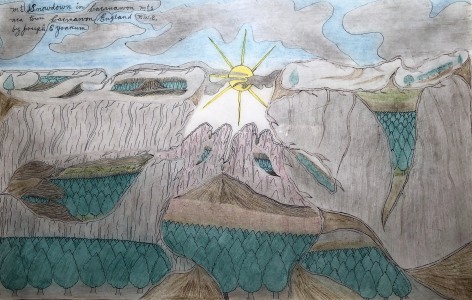
Joseph E Yoakum
Mt Snowdown in Caernarvon Mts
Nea Town Caernarvon England N.W.E. (sic)
by Joseph E Yoakum
Colored pencil and ink on paper
19 x 12 inches
JY 179

Joseph E Yoakum
Arabian Mount Mubarak
Of Saudi Arabia So East Asia
1969
Colored pencil and ink on paper
19 x 12 inches
JY 178
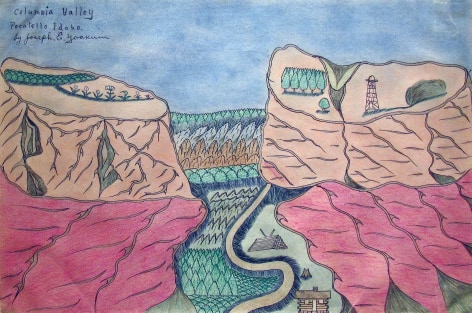
Joseph E. Yoakum
Columbia Valley Pocatello Idaho
By Joseph E. Yoakum
12 x 18 inches
Pen, colored pencil on paper
JY 177

Joseph Yoakum
Grand Coulee Dam in Columbia River
Near Town Keller of South East Washington
Signed, Joseph E. Yoakum
Dated: Oct 11, 1969
Colored pencil and ballpoint pen on paper
12 x 19 inches unframed
JY 175
Joseph Yoakum
Mt. Patrick in Mahoosue Rang
Near Augusta Maine
Signed and dated 1970
Colored pencil and ballpoint pen on paper
12 x 19 inches
JY 174
Joseph Yoakum
Southwest Point of Qzark Mtn Range
Near Carthage Missouri
Pen and colored pencil on paper
12 x 17 3/4 inches
JY 173
Joseph Yoakum
American, 1886-1972
Mt Issoire in Avergne Mtn Range near Clermont France
Signed: by Joseph E. Yoakum
Pen, pencil, colored pencil on paper
12 x 18 inches
JY 172
Joseph Yoakum
Mt. Atilo in Annoi Range,
Colombia South America near Annios
1964
Pen, pencil, colored pencil on paper
12 x 18 inches
JY 171
Joseph Yoakum
Mt. Huerta near Juraz Mexico
Signed: by Joseph E Yoakum
Date: c. 1970
Pen, colored pencil on paper / matted and framed
12 x 19 inches
JY 170
Joseph Yoakum
Untitled / Signed by artist
Date: ND
Pen, colored pencil on paper / matted and framed
12 x 19 inches
JY 169
Joseph Yoakum
c. 1965
Moro Rock and Moro Bay Near San-Luis
Obispo California by Joseph E. Yoakum
Pen and colored pencil on paper
19 x 24 inches
JY 168
Joseph Yoakum
Mt. Shasta 80 Miles West of Susanville
In Circayou County California
Signed: by Josepha E. Yoakum
c. 1975
12 x 19 inches
JY 167
Joseph Yoakum
Mt. Monte Rosa in Jura Alps
Pen, pastel, colored pencil on paper
11 3/4 x 15 1/2 inches
c. 1970
JY 166
Joseph Yoakum
The Vallery of the Moon in Rocky Mtn Range
near Casper Wyoming
May 29, 1966
Signed: by Joseph E. Yoakum
Pen, colored pencil on paper
12 x 19 inches
JY 163
Joseph Yoakum
Dead Sea near Dhioan in Jordan So. East Asia
c. 1970
Colored pencil, pen on paper
12 x 19 inches
JY 165
Joseph Yoakum
Mt. Vesuvios of Apennes Alps near Naples Italy
Signed: by Joseph E. Yoakum
c. 1970
12 x 19 inches
JY 164
Joseph Yoakum
Mt Colio of Vericruz sec: near Town Ciowawa Mexico
Signed: Joseph E. Yoakum
Pen, colored pencil on paper
12 x 18 inches
JY 162
Altai Min. Range - The Platean of Mongolia
1966
Colored pencil, ballpoint pen on paper
12 x 18 inches
JY 147
Blue Mounds Highest Point, of Kansas State
Signed upper left Joseph E. Yoakum
Colored pencils and pen on paper
12 x 18 inches
JY 157
Paradice [sic] Range near Damascus Syria South East Asia
4/23-69
Signed: Joseph E. Yoakum
11 3/4 x 19 inches
Colored pencil and ballpoint pen on paper
JY 156
Joseph Yoakum
In Black Mountain Range Near Montgomery Alabama south U.S.A.
Signed by artist
Colored pencil, ballpoint pen on paper
12 x 19 inches
Date: July 11, 1970
JY 150
Joseph Yoakum
Mt. Cavalery near Bethleham Judea of South East Asia
Signed: Joseph E. Yoakum
8/22-69
Pen, colored pencil on paper
12 x 18 inches
JY 161
a Granit mtn. Riverside Cal.
Signed lower left by Joseph E. Yoakum
Pencil and watercolor on paper
9 x 12 inches
JY 160
This is near St Johs Vermont
Pencil and watercolor on paper
9 x 12 inches
JY 159
Cumberland Mtns near Nashville Tennessee
Signed upper left Joseph E. Yoakum
Colored pencil and pen on paper
12 x 18 inches
JY 158
Master Falls in Amazon River Near Fonte Bon Brazil so America
Signed by artist
Colored pencil, ballpoint pen on paper
12 x 19 inches
Date: 11/23-65
JY 151
Joseph Yoakum
Mt. Jura Between Switzerland and France and Lake Geneva in France.
Signed by artist
Pencil, colored pencil, ball point pen on paper
12 x 19 inches
c. 1965
JY 143
Mt. Gilbert of Appalachian Mtn. Range Polkaz in Pennsylvania
Jan29, 1965
Pencil, Pen, Colored Pencil on Paper
12 x 18 inches
JY139
Mana Kea near Papaikow on Hawaiian Island USA
c. 1969, Signed
Ink, colored pencil on paper
12 x 19 inches
17 x 24 inches (framed)
JY 118
Lake Ferth of Fourth. Eastern Ireland. WE
Pen, pastel, colored pencil on paper
12 x 18 inches
18 1/4 x 24 1/4 inches
JY 109
Yoakum, Joseph
Moosehead Lake near Town of Rockwood in North Central Maine.
11/23- 65
Pen, pastel, colored pencil on paper
12 x 18 inches
18 1/4 x 24 1/4 inches (framed)
JY 108
Yoakum, Joseph
Ozark Mts St. Jeneeveive Mo. J-02-E
Pen, pencil, watercolor on paper
9 x 11 3/4 inches
17 x 19 inches (framed)
JY 105
Joseph Yoakum
Blue Lake Bolevia
c. 1963
Colored pencil on paper
8 3/4 x 11 3/4 inches
JY 87
Joseph Yoakum
John Davis Buffalo Ranch near McCook Nebraska
c. 1967
Pen, colored pencil on paper
12 x 18 inches
JY 82
Joseph E Yoakum
Mt Snowdown in Caernarvon Mts
Nea Town Caernarvon England N.W.E. (sic)
by Joseph E Yoakum
Colored pencil and ink on paper
19 x 12 inches
JY 179
Joseph E Yoakum
Blue Mtns in Ketchum Mtn Range
Near Austin Texas
by Joseph E Yoakum
Colored pencil and ink on paper
19 x 12 inches
JY 180
Joseph Elmer Yoakum (February 22, 1889 – December 25, 1972) was a self-taught landscape artist of African-American and Native American descent, who drew landscapes in a highly individual style. He was 76 when he started to record his memories in the form of imaginary landscapes, and he produced over 2,000 drawings during the last decade of his life. His work is an example of what is sometimes called Outsider Art (formerly, drawings and paintings of the insane).
His official records note that Yoakum was born in Missouri, but he told a story of being born in Arizona, in 1888, as a Navajo Indian on the Window Rock Navajo reservation.Taking pride in his invented native heritage, Yoakum would pronounce "Navajo" as "Na-va-JOE" (as in "Joseph"). His father was a Cherokee Indian, and his mother was a former slave of mixed Cherokee, African-American, and French-American descent. He spent his early childhood on a Missouri farm.
Yoakum left home when he was nine years old to join the Great Wallace Circus. As a billposter, he also traveled across the U.S. with Buffalo Bill's Wild West Show and the Ringling Brothers, among the five different circuses. He later traveled to Europe as a stowaway.
In 1908, he returned to Missouri and started a family with his girlfriend Myrtle Julian, with whom he had his first son in 1909; the couple married in 1910. Yoakum was drafted into army service in 1918 and worked in the 805th Pioneer Infantry repairing roads and railroads.
After the war, he traveled around the U.S. working odd jobs, but he never returned to his family. He later remarried and moved to Chicago. In 1946, Yoakum was committed to a psychiatric hospital there. He soon left and by the early 1950s, he was drawing on a regular basis.
Artistic work
Yoakum was again living and painting in Chicago by 1962. Tom Brand, owner of Galaxy Press on the south side of Chicago, in 1968 had some printing to deliver to a coffee shop called "The Whole". While there he noticed the colored pencil drawings of Yoakum and was immediately taken by them. Brand had an account with the Ed Sherbyn Gallery on the north side of Chicago, and he persuaded Sherbyn to exhibit Yoakum's works and even printed his own poster for this show. Norman Mark of The Chicago Daily News wrote an article about Yoakum called "My drawings are a spiritual unfoldment"; this article was printed on the back of the poster. Brand informed his artist friends (including Whitney Halstead) about Yoakum and encouraged them to visit the Whole coffee shop. Halstead, an artist and instructor at the School of the Art Institute of Chicago, became the greatest promoter of Yoakum's work during his lifetime. He believed that his story was "more invention than reality... in part myth, Yoakum's life as he would have wished to have lived it."
In 1967, Yoakum was discovered by the mainstream art community through John Hopgood, an instructor at the Chicago State College, who saw Yoakum's work hanging in his studio window and purchased twenty-two pictures. A group of students including Roger Brown, Gladys Nillson, Jim Nutt, and Barbara Rossi, and teachers at the School of the Art Institute of Chicago, including Ray Yoshida and Whitney Halstead, took an interest in promoting his work. In 1972, just one month before his death, Yoakum was given a one-man show at the Whitney Museum in New York City.
He started drawing familiar places, such as Green Valley Ashville Kentucky, as a method to capture his memories. However, he shifted towards imaginary landscapes in places he had never visited, like Mt Cloubelle of West India or Mt Mowbullan in Dividing Range near Brisbane Australia. Drawing outlines with ballpoint pen, rarely making corrections, he colored his drawings within the lines using watercolors and pastels. He became known for his organic forms, always using two lines to designate land masses.
During the final four months of his life was marked by a use of pure abstraction, as in his illustration Flooding of Sock River through Ash Grove Mo [Missouri] on July 4, 1914 in that [waters] drove many persons from Homes I were with the Groupe leiving [sic] their homes for safety. That painting was one of his autobiographical works.
